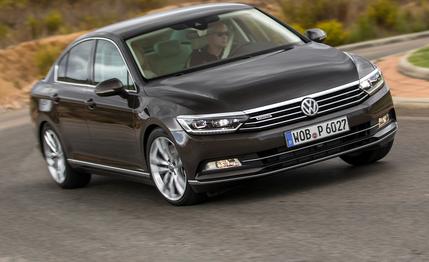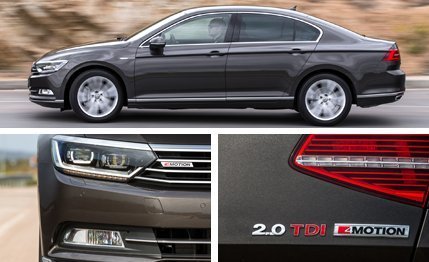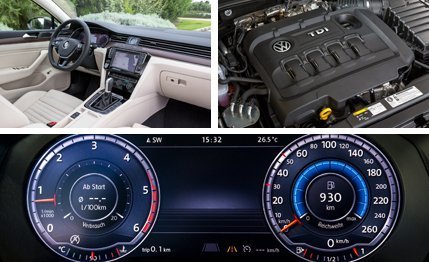 First Drive Review
First Drive Review
When Volkswagen decided it needed to drastically increase sales in the U.S. market, a different Passat was born. Engineered for and built in America, that Passat arrived for the 2012 model year larger than ever before and at a drastically reduced price—but also on a less sophisticated architecture and with fewer available luxury and tech options. At the same time, Europe kept updating its more compact sister model with fresher tech.
And now the divide is widening. While the U.S. Passat, based on the aging PQ46 platform, is getting ready for an extensive face lift next year, the Euro model has been completely redone atop the VW Group's impressive MQB modular vehicle architecture.
Visually, the new model is strictly evolutionary. Designed under the guidance of Marc Lichte, who has since been tapped to head Audi design, the new Passat’s exterior is characterized by horizontal lines and as a result looks sleek and low. In what is perhaps an industry first, the Passat is actually available with two differently shaped headlight units. Its optional LED headlamps are smaller than the standard halogens, and the look is markedly different. VW didn't go as far as changing the sheetmetal surrounding the lights, but the LEDs have a far more prominent chrome strip up top that then carries over into the grille. At the rear, the fanciest LED taillights—there is a lower-spec set, also lit by LED—change their graphics from horizontal to vertical when the brakes are applied.

The Passat is offered with a range of 10 engines in Germany, but we experienced only the 150-hp 1.4-liter TSI gasoline four-cylinder and the burly 240-hp 2.0-liter TDI during our drive. (This story’s accompanying specifications panel is limited to these engines.) Both turbocharged engines are satisfying in their own way. Mated to a slick-shifting manual transmission, the EA211 1.4-liter gasoline engine is surprisingly quick and responsive. It features cylinder deactivation that darkens two holes to reduce fuel consumption (for a deep dive on this incredibly interesting engine, head here), and both this function and the 1.4’s overall soundtrack are very discreet. It provides enough grunt that it doesn’t quite lose any steam until well above 90 mph on its way to a top speed of 137 mph.
The 240-hp four-cylinder twin-turbocharged diesel is simply astounding. Blessed with a whopping 369 lb-ft of torque, it relentlessly pulls the Passat into triple-digit speeds. Despite it being both a four-cylinder and using compression ignition, the NVH characteristics are never harsh or intrusive. We suspect most customers won't miss the two additional cylinders available in the Euro-market Audi A4 diesel range. Especially since this Passat is rather efficient: We reckon it could achieve well into the mid-40-mpg range on the U.S. EPA highway-mileage test, and we wouldn’t be shocked if it could exceed that figure in real-world driving. We estimate zero to 60 mph as taking 6.2 seconds, while top speed sits at 149 mph. The seven-speed dual-clutch automatic transmission shifts rapidly, but it sometimes lacks the finesse and smooth takeoff of a torque-converter automatic. When its software fails to accurately predict the driver's next move, shifts can be slightly jarring.

The Passat is surprisingly agile, particularly with the gasoline engine, and it doesn’t hurt that the big sedan weighs a mere 2900 pounds or so. The diesel model we drove is considerably heavier at nearly 3700 pounds; blame the drivetrain and the myriad standard upgrades on the uplevel car. Both test cars we drove were fitted with the adaptive chassis, which offers three settings. Sport mode preps the Passat for back-road flogging, while the car can do a reasonable approximation of a traditional luxobarge in Comfort mode. There’s also a middle setting that balances the two.
The interior has gone decidedly upscale, with improved materials that include real stitching everywhere, even on the armrests. Every button and knob moves with precision and provides perfect tactile feedback. Even the standard instruments look classy and expensive, but the Passat also offers a large TFT display similar to the one fitted in the new Audi TT. Here, VW has stolen Audi’s thunder, as it will take another year before this technology migrates into the delayed next-gen Audi A4. The cabin is roomy, too, but Europeans can order the attractive wagon variant if they need even more space. Indeed, there are few indications that the new Passat isn’t a premium-brand car. We’re thinking there will be plenty of Continental shoppers asking themselves, “With a VW like this, who needs an Audi?”
While we will continue to get our Chattanooga-assembled Passat for a while, we should get at least one variation of the MQB car, as it has been confirmed to spawn a new version of the CC. We’re definitely looking forward to it.